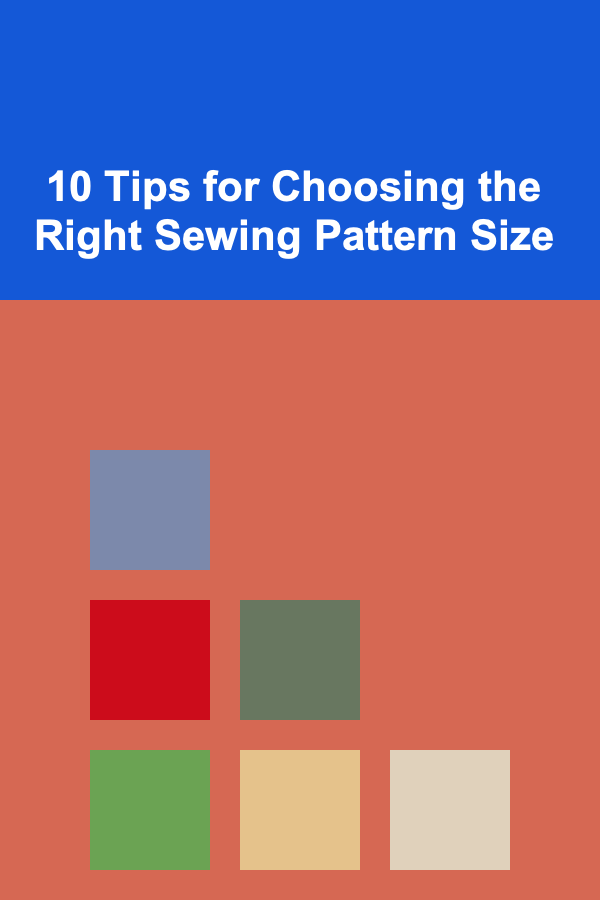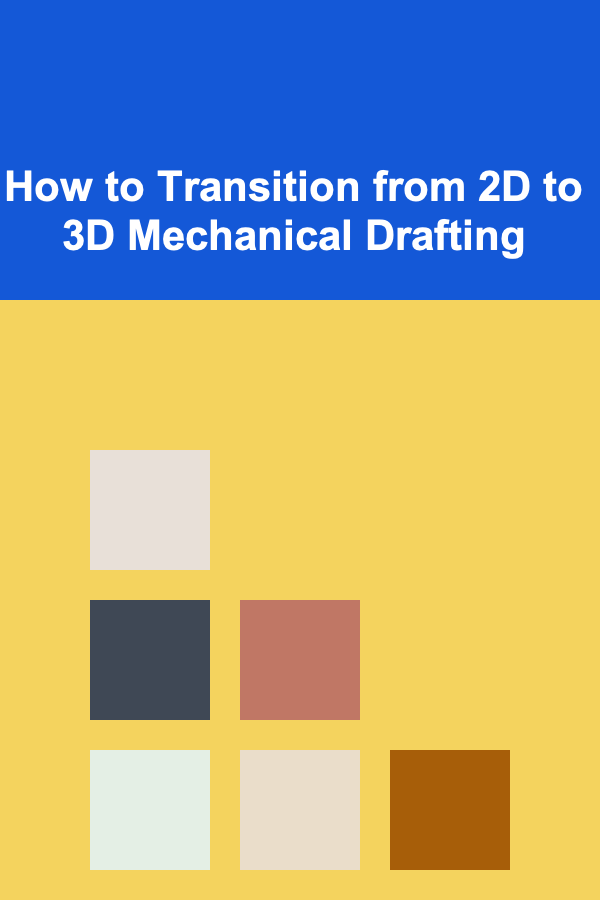
10 Tips for Choosing the Right Sewing Pattern Size
ebook include PDF & Audio bundle (Micro Guide)
$12.99$7.99
Limited Time Offer! Order within the next:

Choosing the right sewing pattern size can be a daunting task for both beginners and seasoned sewists. While it may seem straightforward, it requires a combination of accurate measurements, understanding the fit of a pattern, and knowing how to adjust for personal preferences. Getting the size right is crucial for ensuring your finished garment fits well and looks flattering. Whether you're creating a garment for yourself or someone else, understanding how to navigate sewing patterns and select the best size can make all the difference.
In this article, we'll explore ten essential tips to guide you in choosing the right sewing pattern size, ensuring that your handmade clothes fit like a glove. From taking accurate measurements to making necessary adjustments, these tips will help you feel more confident when sewing your next project.
Take Accurate Measurements
The foundation of selecting the right sewing pattern size is accurate measurements. Pattern sizes are based on body measurements, and taking them correctly ensures you start with a good foundation. The most common measurements you'll need for a pattern include bust, waist, hips, and inseam (for pants). For dresses or tops, measurements may include neck and shoulder width as well.
How to Do It:
- Use a soft measuring tape and measure over the fullest part of your bust, the smallest part of your waist, and the widest part of your hips.
- Make sure to stand naturally, not sucking in your stomach or adjusting your posture to avoid skewed measurements.
- Record the measurements while keeping the tape comfortably snug but not tight.
It's essential to take your measurements with a relaxed, natural stance, so you get the most accurate results.
Check the Size Chart of the Pattern
Every sewing pattern comes with its own size chart, which usually includes a range of measurements for each size. It's crucial to compare your body measurements with the size chart provided by the pattern company. Most patterns use a range of measurements (for example, small, medium, or large) or numerical sizes, but it's the actual measurements that matter more than the size label.
How to Do It:
- Look for a size chart in the pattern instructions, often included at the back of the envelope or on the pattern company's website.
- Compare your bust, waist, and hip measurements to the size chart. The pattern size you choose should correspond to the measurement that fits you best at each key point.
- Don't be afraid to go up or down a size based on where you fall on the chart. It's common to be different sizes at the bust, waist, and hips.
By comparing your measurements with the size chart, you can ensure a more tailored fit right from the start.
Understand the Ease of the Pattern
Ease refers to the extra space included in a pattern beyond your body measurements, which allows for comfort and movement. Each pattern includes a specific amount of ease, which varies depending on the intended style and fit. For example, a fitted garment like a sheath dress will have less ease, while a loose-fitting blouse will have more ease.
How to Do It:
- Read the pattern's instructions to understand how much ease is built into the design. Most patterns indicate whether the fit is designed to be loose, semi-fitted, or close-fitting.
- If you prefer a more relaxed or snug fit, you can adjust the ease by choosing a size larger or smaller than what the size chart recommends.
Understanding how much ease is built into the pattern helps you choose the right size for your desired fit.
Account for Personal Fit Preferences
Everyone has different preferences when it comes to fit. Some people prefer their clothes to be more snug, while others like a looser, more relaxed fit. Your personal preference for fit plays a crucial role in how you should select your size. If you like a looser fit, you may want to go up a size, while a tighter fit may require a size down.
How to Do It:
- Think about the way you want the garment to fit your body. Do you like a tailored, form-fitting look, or do you prefer something with more room and comfort?
- Don't be afraid to adjust the pattern to accommodate your preferences. It's common to choose a size based on where you want the garment to sit (e.g., waist, bust, or hips).
Knowing your personal preferences will help you make more informed decisions about which size to select.
Consider Fabric Type and Stretch
The type of fabric you choose can greatly impact the final fit of your garment. Fabrics with more stretch (such as knit fabrics) may require you to size down because they will naturally conform to your body. On the other hand, fabrics with little or no stretch (like cotton or linen) may require you to stick to your standard size or size up for comfort.
How to Do It:
- Read the fabric recommendations on the pattern instructions. If the pattern calls for a stretch fabric and you plan to use a non-stretch fabric, you may need to size up.
- If you're using a fabric with a lot of stretch, consider sizing down to avoid the garment becoming too loose.
Knowing how your fabric behaves is essential in ensuring a proper fit and maintaining the integrity of the pattern's intended style.
Pay Attention to Finished Garment Measurements
While your body measurements are important, the finished garment measurements also provide valuable insight into how the garment will fit once made. These measurements tell you the actual dimensions of the garment at specific points (e.g., bust, waist, hip, and length), so you can see how it compares to your measurements before making a final decision.
How to Do It:
- Look for finished garment measurements in the pattern instructions or on the company's website. These measurements are typically listed alongside the sizing information.
- Compare the finished garment measurements to your body measurements to ensure that the garment will fit as you expect.
Using the finished garment measurements helps ensure that the pattern size you choose aligns with your desired fit.
Make Muslins or Toile
One of the best ways to test the fit of a pattern is to make a muslin or toile---a practice garment made from inexpensive fabric. This allows you to try on the pattern before cutting into your chosen fabric and make any necessary adjustments.
How to Do It:
- Choose a cheap fabric (such as muslin or cotton) and cut out the pattern pieces.
- Sew the muslin garment together without finishing the edges. Try it on and assess the fit.
- Make note of any areas that need adjusting, such as the waistline, bust, or length, and transfer these adjustments to the pattern.
Making a muslin is an excellent way to test the fit and make changes without committing to expensive fabric.
Adjust for Proportions and Body Shape
We all have different body shapes and proportions, and it's important to account for these when choosing a pattern size. If you have a longer torso or shorter legs, you may need to adjust the length of the pattern. Similarly, if your bust, waist, and hips are not in proportion with the pattern size, you might need to grade between sizes.
How to Do It:
- If your bust, waist, and hip measurements differ significantly, consider grading between sizes. For example, you might use a larger size for the bust and a smaller size for the waist and hips.
- For changes in length, you can lengthen or shorten the pattern at key points (such as the bodice or skirt length) to suit your proportions.
Adjusting for your proportions ensures that the pattern will work for your unique body shape.
Use Pattern Fitting Guides or Tools
Many pattern companies offer additional resources, such as fitting guides or tools, to help you select the right size. These tools can guide you through the process of fitting and making adjustments based on your measurements and preferences.
How to Do It:
- Look for fitting guides or video tutorials offered by the pattern company.
- Use online fitting calculators or apps to help determine the best size based on your measurements.
These resources can provide valuable insights and support in choosing the right size and making necessary adjustments.
Don't Be Afraid to Make Adjustments
Even after selecting your size, it's common to make adjustments to ensure the perfect fit. These adjustments could include altering the length, changing the waistline, or adjusting the fit at the bust or hips. Sewing is a creative process, and adjustments are a normal part of making a garment that suits you perfectly.
How to Do It:
- After trying on your muslin, mark any areas that need to be adjusted, whether it's lengthening, shortening, or taking in certain parts.
- Use the markings on your pattern to make alterations. For example, you may need to add or remove fabric at the side seams or adjust the darts.
- Always test any alterations on your muslin before transferring them to your final fabric.
Making adjustments ensures that the final garment will fit perfectly and match your desired style.
Conclusion
Choosing the right sewing pattern size can seem like a complicated process, but by following these ten tips, you'll be well on your way to creating garments that fit beautifully. Take accurate measurements, understand your fit preferences, and don't be afraid to make adjustments as needed. By investing time in selecting the right size and making necessary alterations, you'll end up with a garment that fits perfectly and reflects your personal style. Happy sewing!
Reading More From Our Other Websites
- [Personal Investment 101] Make Money with Deep Learning by Building Custom AI Models for Businesses
- [Organization Tip 101] How to Keep Your Craft Area Child-Friendly
- [Organization Tip 101] How to Plan DIY Gifts for Family and Friends
- [Personal Finance Management 101] How to Plan for Major Life Events Financially
- [Organization Tip 101] How to Create a Shared Space Agreement with Roommates
- [Organization Tip 101] How to Use Drawer Dividers for Better Organization
- [Organization Tip 101] What Are Some Fun Ideas for Organizing Your Craft Supplies?
- [Reading Habit Tip 101] Digital Pages vs Paper: Which Reading Experience Wins?
- [Personal Care Tips 101] Best Personalized Skincare Routines for Mature, Sensitive Skin
- [Home Soundproofing 101] How to Soundproof a Gaming Room for the Ultimate Audio Experience

How to Build a Website to Showcase Your Travel Photography Portfolio: A Comprehensive Guide
Read More
Designing a Net-Zero Energy Community: A Comprehensive Guide
Read More
How to Track Debt Payoff with the Debt Snowball Method
Read MoreHow to Integrate a To-Do List with Your Habit Tracker
Read More
How to Transition from 2D to 3D Mechanical Drafting
Read More
How to Handle Petty Cash Discrepancies: A Comprehensive Guide
Read MoreOther Products

How to Build a Website to Showcase Your Travel Photography Portfolio: A Comprehensive Guide
Read More
Designing a Net-Zero Energy Community: A Comprehensive Guide
Read More
How to Track Debt Payoff with the Debt Snowball Method
Read MoreHow to Integrate a To-Do List with Your Habit Tracker
Read More
How to Transition from 2D to 3D Mechanical Drafting
Read More